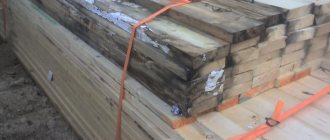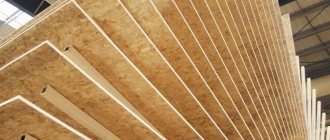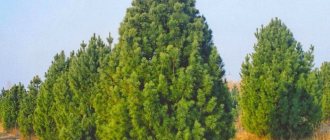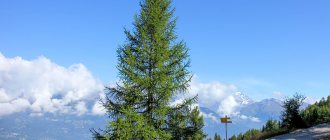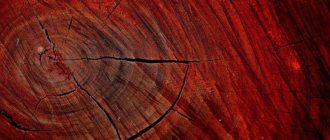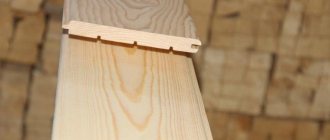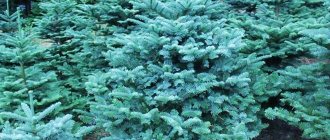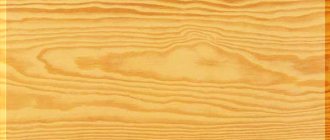On the territory of Russia, as experts know, there are more than 50 species of well-known pine. This tree is valued in the timber processing industry for the special characteristics of its wood, which make it possible to widely use harvested lumber. The scope of use of the prepared resin wood also depends on where the preliminary wood harvesting takes place.
Structure and properties
Pine is a soundwood species. As pine lumber is dried and stored, the color of the core becomes darker, becoming a reddish-brown hue. It should be noted that late pine wood is always darker than early wood.
Tree rings are clearly visible in tangential and radial sections, forming a wavy pattern. Large and numerous resin passages are visible in the form of dark stripes.
Pine texture
Pine wood has medium density, good resistance to decay and high strength. It should be noted that sapwood is less resistant to diseases and insect pests, and therefore requires treatment with protective compounds. Wet sapwood (more than 25%) can be easily affected by fungi that cause blue staining of the wood. This disease does not cause a significant deterioration in the mechanical properties of pine lumber, but the appearance of the products suffers from this.
Pine wood
The uniform texture of pine is determined by the difference in the color of the sapwood and heartwood, early and late wood and the different width of the growth rings. Due to the fact that the structure of late and early wood is very different from each other, pine has low uniform density. Areas of the late annual layer have a density 2-3 times higher than that of the early annual layer.
The thickness of the annual rings can vary, from 2-3 mm to 9-10, with late wood occupying up to 26-28% of the annual layer. Pine harvested in Russian forests has a different number of annual layers per 1 cm; this number ranges from 4 to 14.
In the European north of Russia, “ore” (or “kondova”) pine is harvested. This species grows at higher elevations, preferring sandy and sandy loam soils. The wood of such trees is dense and fine-grained, and has a narrow sapwood. The trunk is straight, with a slight slope, very resinous, with few knots.
In low-lying areas with clay soil, pine trees grow, which are called “myandovo”. They have softer wood, less resinous, and are inferior in mechanical characteristics to “ore”.
In the struggle for a place in the sun, pines grow to great heights, forming smooth cylindrical trunks. This makes it possible to obtain long, smooth lumber without knots. This material can be easily processed with a cutting tool and does not crack when dried. Pine wood has a beautiful, well-defined grain, a pleasant yellow to reddish-brown color, and is widely used in carpentry. It is successfully used by wood carvers for their artistic products.
Based on the resin content in pine wood, two varieties are determined: dried wood chips (another name is dutitsa) and resin. The first has a minimal resin content and is light in weight, while the second is heavily resinous and heavy.
Resinous pine cut against the light
Because of such differences, rafts for river rafting were made only from dry wood chips, and tar was taken out by transport, since there was a high probability that it would sink. But this type of pine wood is very resistant to moisture; drowned logs could lie in water for years and still not lose their properties. It is not for nothing that it was used in the construction of bridges, river and sea piers.
Combinations
Light brown color harmonizes well with pastel tones of warm shades: red, yellow, orange. Adding cool pastel colors will create a pleasant contrast, and bright acidic shades should be approached carefully so as not to turn a cozy interior into kitsch.
Pine looks great in combination with other species, as well as against a brown background. However, “wooden” shades should be diluted with other colors, otherwise the room will become too monolithic.
Sold in the form of boards, veneers and beams.
Treatment
For carpentry work, they try to use non-resinous pine wood. Processing wood with a high resin content is difficult because the tool becomes clogged with resin. Resinous wood waste sticks to it and interferes with work. Sanding such wood is problematic; the sanding paper immediately becomes clogged with resinous dust. The resin bleeds through coatings, spoiling the appearance, and when accidentally heated, it swells, lifting the paint or varnish layer. Therefore, if it is necessary to use resin, it is treated with chemicals to remove the resin.
Pine wood with a low resin content is easily processed with hand and power tools. Planing along the grain does not cause any difficulties, but cutting across the grain is unsatisfactory and it is difficult to obtain a clean end cut. The wood lends itself very well to sanding operations; the surface quality is better than that of oak or ash.
It can be painted with stains and mordants, but sometimes the resin has a negative effect on such operations. It is easily painted with varnishes and paints, but wood has high moisture permeability, which leads to increased consumption of such materials.
The pine glues well, the connection using fasteners (nails, screws) is satisfactory. Among all the coniferous tree species from which commercial wood is harvested, pine rightfully takes first place. Pine wood comes to the consumer in the form of round timber and lumber (boards, beams). Materials made from pine wood - chipboard, plywood and veneer - are also widely represented on the market. Manufacturers also offer ready-made building structures made of pine - doors, windows, etc.
Use of pine wood
Pine wood can be used in a wide variety of industries.
In construction, wood is used as materials for structures and decoration. In addition, mechanical engineering, furniture production, railway transport, etc. are essential without pine wood. Resin is extracted from pine. Pine needles are used to produce biologically active substances.
Pine is not very popular in furniture production. Typically, its resinous and soft wood is used to make cabinet furniture. At the same time, thick veneer of more noble species (for example, mahogany) is used to cover the pine frame.
Most often, pine is used in the construction of saunas and stairs. But first, the wood is treated to remove excess resin and compaction. Light pine panels are not only very beautiful, but also smell pleasant. In addition, pine wood is inexpensive, so manufacturers of saunas in the economy class category use this wood. For simpler saunas, as a rule, ordinary pine is used, and for elite-class saunas, Canadian pine (hemlock) is used.
Physical properties of pine
Humidity
The sapwood of a growing tree has high humidity, reaching up to 120%. The core has lower humidity (2.5-3 times less than the moisture content of sapwood) and practically does not change with the height of the tree.
At different times, the value and moisture content of wood is different. In the morning, the humidity level is 25-30% higher than the average and reaches its maximum. During this period, this indicator gradually decreases to a minimum (30-35% below the average level). In the evening and night hours there is an increase in humidity.
Drying
Before use, pine wood is dried to a standard moisture content of 12%. Drying can be either natural, in the open air under canopies, or in special dryers. Pine is less susceptible to warping and cracking when dried. Choosing the optimal mode in the drying chamber and proper stacking of lumber allows you to reduce the percentage of rejects to a minimum.
Density
Coniferous wood, including pine, has a low density. The average density of pine wood (at a humidity of 12%) ranges from 500 to 520 kg/cub.m. Density limits range from 350 to 800 kg/cub.m.
Permeability
Pine wood is characterized by high values of moisture permeability and air permeability. The values of these indicators are determined by creating an excess pressure of 0.1 MPa on one side of the sample. For the core this value is 2.6 cubic mm/sq.cm/s, for sapwood - 56.2 cubic mm/sq.cm/s. It can be noted that the same indicator for oak wood does not exceed 0.13 cubic mm/sq.cm/s.
Having such high moisture permeability rates, pine is easily impregnated with various antiseptics and protective compounds.
Thermal properties
In terms of its thermal conductivity characteristics, pine wood significantly exceeds metals (in particular, aluminum) and slightly exceeds polyvinyl chloride. That is why windows made from pine are superior in performance to windows made from aluminum profiles.
Mechanical properties of pine
Strength
Pine wood, harvested in the north of the European part of Russia, has the best mechanical strength. In terms of strength characteristics, only Caucasian fir has the best performance.
Features of pine products and reviews
Pine wood is used most often in Russia due to the fact that this particular type of lumber can be purchased at any time at a low cost.
Features of this tree include:
- Ease of processing.
- Strength and durability.
- Possibility of independent work with wood.
“I decided to build a bathhouse from pine because I couldn’t find a cheaper and at the same time safe, easy to process and durable material. I bought timber in the spring and by mid-July my bathhouse was completely ready. I sometimes heat a sauna twice a week, after it I feel great, fresh air, good steam, long-term heat retention - this is how I can describe the special sensations from my building” - Pavel, 42 years old.
The main pros and cons of pine wood
Any wood has a set of certain pros and cons, which must be taken into account when making various products from this lumber.
The advantages of pine wood include:
- Increased durability.
- Attractive colors and distinct texture.
- Health safety.
- No rotting when properly processed.
- Ease of carrying out various carpentry works.
- Low price of harvested lumber.
Pine wood also has its disadvantages. This is mainly due to the softness of the wood and therefore dents may remain on such products after mechanical stress. The area where the pine grows is also important when determining the defects of wood.
If this tree has grown in a humid environment, then its wood will be characterized by increased friability, which requires a long drying process.
Pine wood will always be in high demand. With its help, you can build budget houses that are of excellent quality and durability. You can purchase pine lumber in almost any region of Russia.
Technical and operational properties
Pine wood is soft and can be easily processed with carpentry tools.
Products made from pine are easily sanded, forming a surface of a high class of cleanliness; micro-irregularities in height do not exceed 60 microns. In terms of these indicators, pine exceeds maple and ash, in which microroughness reaches a value of 200 microns, which is due to the structure of the wood of these species.
Pine is moderately resistant to damage by fungi and insect pests. The kernel is more resistant to biological influences compared to sapwood.
See also:
Wood species
Wood processing
Join the VKontakte and Odnoklassniki groups
Material quality
Another important point: the quality of the material, namely:
- the presence of that very blue color, quickly spreading throughout the entire thickness of raw wood,
- tendency to cracks during drying,
- tendency to warp and curl when storing improperly dried or underdried lumber.
Pine is a very capricious material in terms of drying. And not every company, even with the appropriate equipment, can comply with the technology. In particular, choose the right temperature conditions and ensure low final humidity (below 10-12%). As a result, the above-mentioned defects appear in workpieces or, over time, even in finished products, which is doubly unpleasant. You don’t have to look far for an example - slats, bars and boards, curved and twisted along the longitudinal axis, can be found in the nearest hardware store.
Pine in landscaping
Olga Nikitana
Pines are one of the most beautiful representatives of the coniferous class, which have deservedly become widespread in culture in almost all regions of the earth. In the conditions of central Russia with long and frosty winters, pines, like other representatives of conifers, are irreplaceable, since only they are able to maintain the decorative appearance of the garden throughout the year.
Usage
In spring, pine needles set off the delicate greenery of awakening deciduous trees, serve as an ideal backdrop for flower beds, trees, and shrubs with unusual leaf colors, and in autumn they expressively contrast with the riot of colors of the forest. In winter, the finest hour of conifers comes - they become the dominants of the garden, maintaining the volume and structure of the composition.
Of greatest interest for landscaping are the varieties and garden forms of pine trees, distinguished by their unusual sizes, crown shape, and needle color. Among the decorative representatives of pines there are specimens with columnar, spherical, compacted, creeping crown forms; the needles can be not only traditionally green, but also silver, golden, with contrastingly colored tips and even variegated. By skilfully arranging such unusual accents you can make the garden more original and individual.
The use of pine trees in gardening is universal. Pine trees are undoubtedly good as tapeworms planted on the lawn. The rich color of the powerful trunks, the elegant spreading crown, and the beautiful structure of the plastic branches delight the eye and, despite the familiar appearance, never become boring. Groups with pine trees perform many functions: they divide the garden into separate zones, cover unaesthetic buildings and fences, serve as backdrops for framing open spaces, emphasize the advantages of the layout of the territory, and create contrasting compositions with deciduous trees and flowering shrubs. If in large gardens and parks groups of species of the same species look appropriate, then landscaping a small garden requires a combination of different species and varieties. Groups of conifers, composed according to the principle of contrasting the color of the needles and the shape of the plant, look very impressive. In such compositions, pines go well with firs, bluish spruces, junipers, and golden thujas.
Excellent companions of conifers, both from an aesthetic and agrotechnical point of view, are many deciduous shrubs: heathers and ericas, rhododendrons and hydrangeas, barberries and spirea, Kuril tea and mahonias, blueberries and lingonberries. Perennial herbaceous plants will help complement and enliven the composition: hostas, ferns, daffodils, irises, violas, bells, bulbous primroses. In the foreground, groundcovers look good: sedum, saxifrage, cat's foot and similar species.
Compact and dwarf pine species are indispensable for background plantings and are successfully used in the design of rockeries, alpine slides, and flower arrangements. The smallest varieties are popular for creating dwarf trees in the bonsai style.
Pines are also beautiful when planted as evergreen alleys and hedges, but a more compact plant can be created by pinching out buds and pruning young shoots.
Among the decorative representatives of pines there are specimens with columnar, spherical, compacted, creeping crown forms.
Types and varieties
Most representatives of the Pine genus are unpretentious and hardy, growing well in light, well-drained soils. Dwarf varieties require a denser and more nutritious substrate, but you should not overuse fertilizing, as they may lose their typical crown shape. It must be remembered that most species are very light-loving and with a lack of lighting, the shoots become very elongated - this leads to a loss of compactness of the crown and the attractiveness of the entire plant.
Scots pine : 'Fastigiata' is a slow-growing tree 6–8m high. The needles are thick, bluish, the branches are directed vertically upward. 'Watereri' is a dwarf tree 3–4 m high, with a dense, wide-conical crown shape. ' Aurea ', 'Gold Medal' - in these varieties, by winter, the tips of the needles turn golden, and in 'Alba' - bluish-green.
Mountain pine : 'Mops' is a dwarf bush with a spherical crown. 'Gnom' – tall bush, tightly compressed, spherical crown. 'Mughus' is a prostrate, slow-growing shrub. 'Pumilio' is a creeping shrub with shoots directed upwards. 'Winter Gold' – in winter the needles of this variety acquire a light golden color. A variety of decorative varieties also have s. black and s. Siberian cedar.
There are many varieties and garden forms of pine trees, which allows you to choose a suitable specimen for any type and size of garden in a wide variety of climatic conditions.
| Aleppo pine | Italian pine | Italian pine |
Aleppo pine

